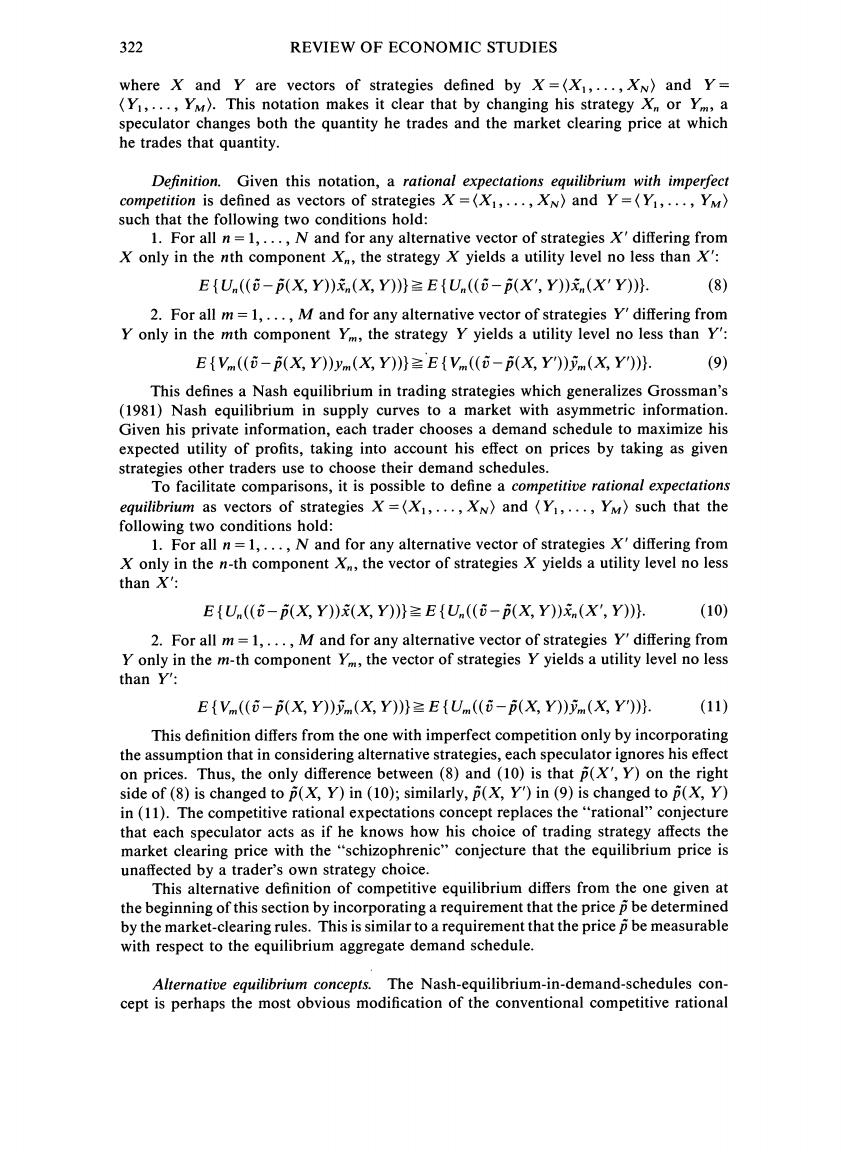
322 REVIEW OF ECONOMIC STUDIES where X and Y are vectors of strategies defined by X=(X1,...,XN)and Y= (Y1,...,YM).This notation makes it clear that by changing his strategy X or Yim,a speculator changes both the quantity he trades and the market clearing price at which he trades that quantity. Definition.Given this notation,a rational expectations equilibrium with imperfect competition is defined as vectors of strategies X=(X1,...,XN)and Y=(Y1,...,YM) such that the following two conditions hold: 1.For all n=1,...,N and for any alternative vector of strategies X'differing from X only in the nth component X,the strategy X yields a utility level no less than X': EU(((X,Y))(X,Y))EU((-(X',Y))(X'Y))) (8) 2.For all m=1,...,M and for any alternative vector of strategies Y'differing from Y only in the mth component Yim,the strategy Y yields a utility level no less than Y': EV ((-(X,Y))vm(X,Y))EV ((6-p(X,Y))(X,Y))) (9) This defines a Nash equilibrium in trading strategies which generalizes Grossman's (1981)Nash equilibrium in supply curves to a market with asymmetric information. Given his private information,each trader chooses a demand schedule to maximize his expected utility of profits,taking into account his effect on prices by taking as given strategies other traders use to choose their demand schedules. To facilitate comparisons,it is possible to define a competitive rational expectations equilibrium as vectors of strategies X=(X1,...,XN)and (Y1,...,Ym)such that the following two conditions hold: 1.For all n=1,...,N and for any alternative vector of strategies X'differing from X only in the n-th component X,the vector of strategies X yields a utility level no less than X': EU((-(X,Y))X,Y)))EU((-(X,Y))(X',Y))). (10) 2.For all m=1,...,M and for any alternative vector of strategies Y'differing from Y only in the m-th component Ym,the vector of strategies Y yields a utility level no less than Y: EV((-p(X,Y))(X,Y))EU((-(X,Y))(X,Y))). (11) This definition differs from the one with imperfect competition only by incorporating the assumption that in considering alternative strategies,each speculator ignores his effect on prices.Thus,the only difference between (8)and (10)is that p(X',Y)on the right side of (8)is changed to p(X,Y)in (10);similarly,p(X,Y')in (9)is changed to p(X,Y) in (11).The competitive rational expectations concept replaces the"rational"conjecture that each speculator acts as if he knows how his choice of trading strategy affects the market clearing price with the "schizophrenic"conjecture that the equilibrium price is unaffected by a trader's own strategy choice. This alternative definition of competitive equilibrium differs from the one given at the beginning of this section by incorporating a requirement that the price p be determined by the market-clearing rules.This is similar to a requirement that the price p be measurable with respect to the equilibrium aggregate demand schedule. Alternative equilibrium concepts.The Nash-equilibrium-in-demand-schedules con- cept is perhaps the most obvious modification of the conventional competitive rational
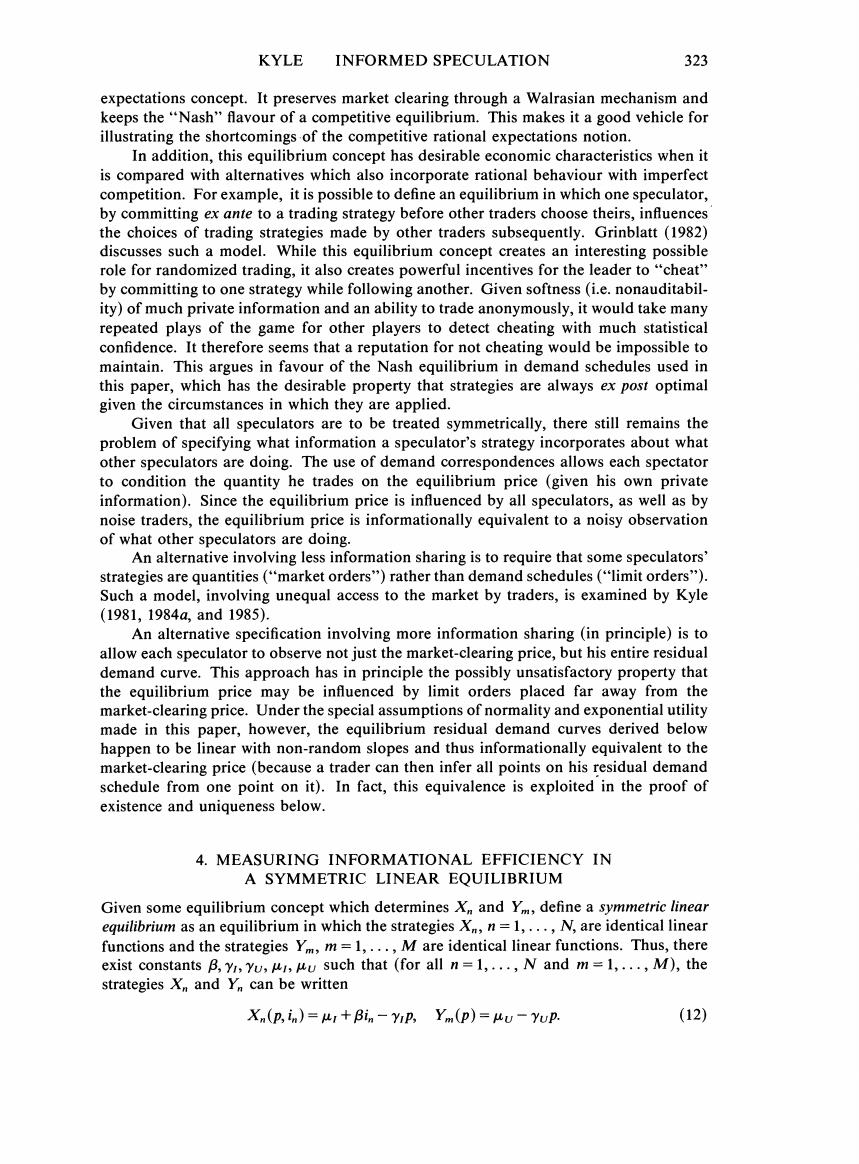
KYLE INFORMED SPECULATION 323 expectations concept.It preserves market clearing through a Walrasian mechanism and keeps the"Nash"flavour of a competitive equilibrium.This makes it a good vehicle for illustrating the shortcomings of the competitive rational expectations notion. In addition.this equilibrium concept has desirable economic characteristics when it is compared with alternatives which also incorporate rational behaviour with imperfect competition.For example,it is possible to define an equilibrium in which one speculator, by committing ex ante to a trading strategy before other traders choose theirs,influences the choices of trading strategies made by other traders subsequently.Grinblatt(1982) discusses such a model.While this equilibrium concept creates an interesting possible role for randomized trading,it also creates powerful incentives for the leader to"cheat" by committing to one strategy while following another.Given softness(i.e.nonauditabil- ity)of much private information and an ability to trade anonymously,it would take many repeated plays of the game for other players to detect cheating with much statistical confidence.It therefore seems that a reputation for not cheating would be impossible to maintain.This argues in favour of the Nash equilibrium in demand schedules used in this paper,which has the desirable property that strategies are always ex post optimal given the circumstances in which they are applied. Given that all speculators are to be treated symmetrically,there still remains the problem of specifying what information a speculator's strategy incorporates about what other speculators are doing.The use of demand correspondences allows each spectator to condition the quantity he trades on the equilibrium price (given his own private information).Since the equilibrium price is influenced by all speculators,as well as by noise traders,the equilibrium price is informationally equivalent to a noisy observation of what other speculators are doing. An alternative involving less information sharing is to require that some speculators' strategies are quantities("market orders")rather than demand schedules("limit orders"). Such a model,involving unequal access to the market by traders,is examined by Kyle (1981,1984a,and1985). An alternative specification involving more information sharing (in principle)is to allow each speculator to observe not just the market-clearing price,but his entire residual demand curve.This approach has in principle the possibly unsatisfactory property that the equilibrium price may be influenced by limit orders placed far away from the market-clearing price.Under the special assumptions of normality and exponential utility made in this paper,however,the equilibrium residual demand curves derived below happen to be linear with non-random slopes and thus informationally equivalent to the market-clearing price (because a trader can then infer all points on his residual demand schedule from one point on it).In fact,this equivalence is exploited in the proof of existence and uniqueness below. 4.MEASURING INFORMATIONAL EFFICIENCY IN A SYMMETRIC LINEAR EQUILIBRIUM Given some equilibrium concept which determines Xn and Ym,define a symmetric linear equilibrium as an equilibrium in which the strategies X,n=1,...,N,are identical linear functions and the strategies Ym,m=1,...,M are identical linear functions.Thus,there exist constants B,yr,Yu,uu such that (for all n=1,...,N and m=1,...,M),the strategies X and Y can be written Xn(p,in)=ur+Bin-Yip,Ym(p)=uu-Yup. (12)
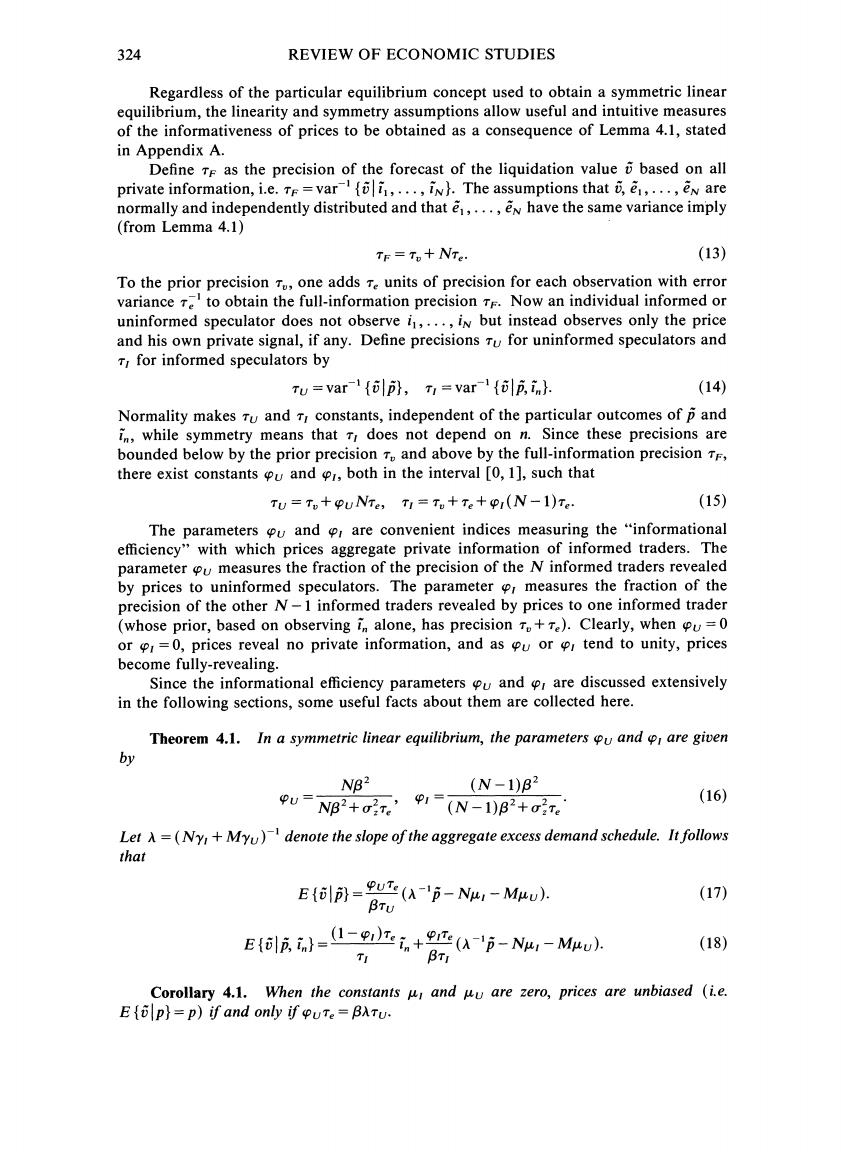
324 REVIEW OF ECONOMIC STUDIES Regardless of the particular equilibrium concept used to obtain a symmetric linear equilibrium,the linearity and symmetry assumptions allow useful and intuitive measures of the informativeness of prices to be obtained as a consequence of Lemma 4.1,stated in Appendix A. Define TF as the precision of the forecast of the liquidation value based on all private information,i.e.T=var,...,iN).The assumptions that ,...,en are normally and independently distributed and that e1,...,ew have the same variance imply (from Lemma 4.1) TF =To+NTe. (13) To the prior precision To,one adds Te units of precision for each observation with error variance re to obtain the full-information precision TF.Now an individual informed or uninformed speculator does not observe i1,...,in but instead observes only the price and his own private signal,if any.Define precisions Tu for uninformed speculators and T,for informed speculators by TU =var p),TI=var p,in) (14) Normality makes ru and T constants,independent of the particular outcomes of p and in,while symmetry means that Tr does not depend on n.Since these precisions are bounded below by the prior precision To and above by the full-information precision TF, there exist constants and both in the interval [0,1],such that TU=To+PuNTe,TI=To+Te+pi(N-1)Te. (15) The parameters u and r are convenient indices measuring the "informational efficiency"with which prices aggregate private information of informed traders.The parameter u measures the fraction of the precision of the N informed traders revealed by prices to uninformed speculators.The parameter or measures the fraction of the precision of the other N-1 informed traders revealed by prices to one informed trader (whose prior,based on observing in alone,has precision T+re).Clearly,when u=0 orr=0,prices reveal no private information,and as u or tend to unity,prices become fully-revealing. Since the informational efficiency parameters u and r are discussed extensively in the following sections,some useful facts about them are collected here. Theorem 4.1.In a symmetric linear equilibrium,the parameters pu and o are given by NB2 (N-1)B2 PU-NB2+I(N-1)B+ (16) Let A=(Ny+Myu)denote the slope of the aggregate excess demand schedule.Itfollows that E(p)=PuT (A-6-Nu-Muu). (17) BTu E)=(A--Nur-MuU). (18) TI BTI Corollary 4.1.When the constants w and uu are zero,prices are unbiased (i.e. E{p}=p)if and only if ouTe=BATu
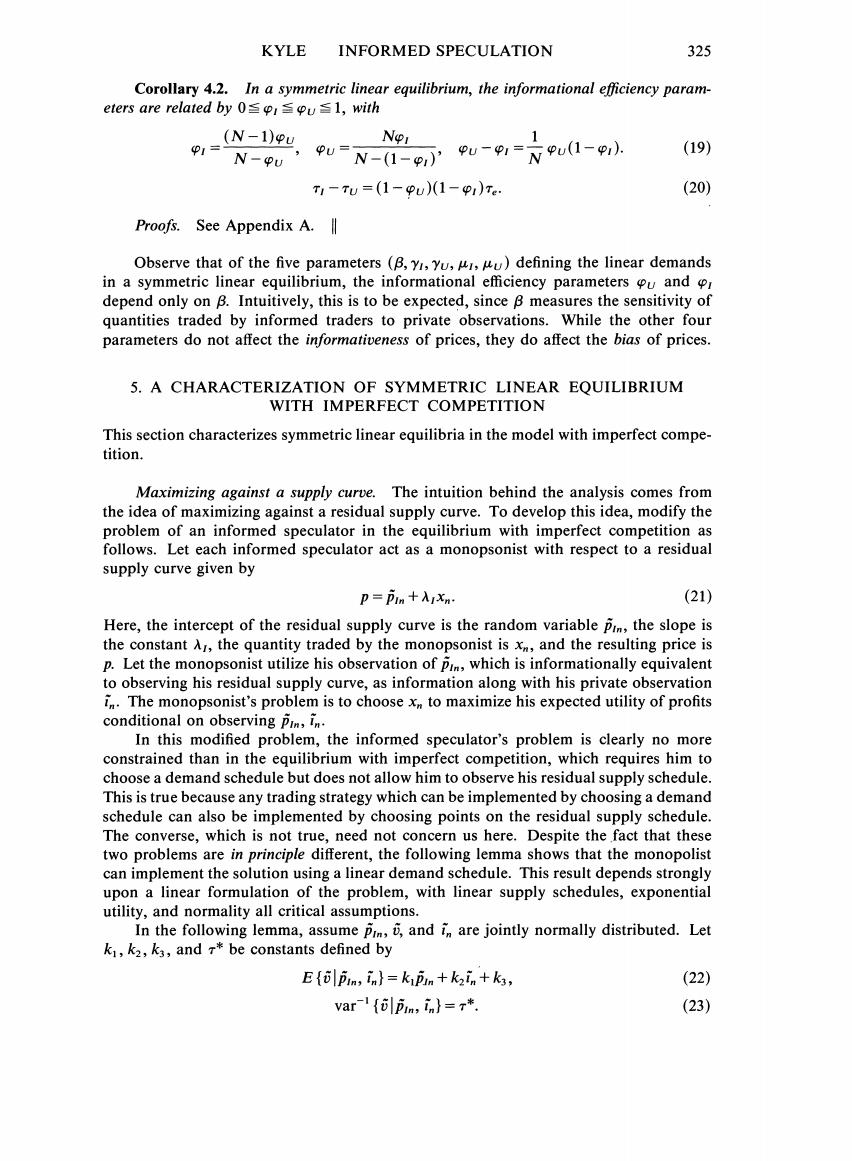
KYLE INFORMED SPECULATION 325 Corollary 4.2.In a symmetric linear equilibrium,the informational efficiency param- eters are related by 01,with (N-1)Pu Nor P1= N-PU-N-(1)PU-PI-NPU(1-P1). (19) T1-Tu=(1-pu)(1-p1)Te (20) Proofs.See Appendix A. Observe that of the five parameters(B,yi,Yu,ur,u)defining the linear demands in a symmetric linear equilibrium,the informational efficiency parameters u and pr depend only on B.Intuitively,this is to be expected,since B measures the sensitivity of quantities traded by informed traders to private observations.While the other four parameters do not affect the informativeness of prices,they do affect the bias of prices. 5.A CHARACTERIZATION OF SYMMETRIC LINEAR EQUILIBRIUM WITH IMPERFECT COMPETITION This section characterizes symmetric linear equilibria in the model with imperfect compe- tition. Maximizing against a supply curve.The intuition behind the analysis comes from the idea of maximizing against a residual supply curve.To develop this idea,modify the problem of an informed speculator in the equilibrium with imperfect competition as follows.Let each informed speculator act as a monopsonist with respect to a residual supply curve given by p=pPin+Arxn. (21) Here,the intercept of the residual supply curve is the random variable prm,the slope is the constant A,the quantity traded by the monopsonist is x,and the resulting price is p.Let the monopsonist utilize his observation of pim,which is informationally equivalent to observing his residual supply curve,as information along with his private observation i.The monopsonist's problem is to choose x to maximize his expected utility of profits conditional on observing Pim,in. In this modified problem,the informed speculator's problem is clearly no more constrained than in the equilibrium with imperfect competition,which requires him to choose a demand schedule but does not allow him to observe his residual supply schedule. This is true because any trading strategy which can be implemented by choosing a demand schedule can also be implemented by choosing points on the residual supply schedule. The converse,which is not true,need not concern us here.Despite the fact that these two problems are in principle different,the following lemma shows that the monopolist can implement the solution using a linear demand schedule.This result depends strongly upon a linear formulation of the problem,with linear supply schedules,exponential utility,and normality all critical assumptions. In the following lemma,assume pi,and in are jointly normally distributed.Let k1,k2,k3,and T*be constants defined by E pin;in}kipin +k2in+k3, (22) var(pin,in)=T*. (23)
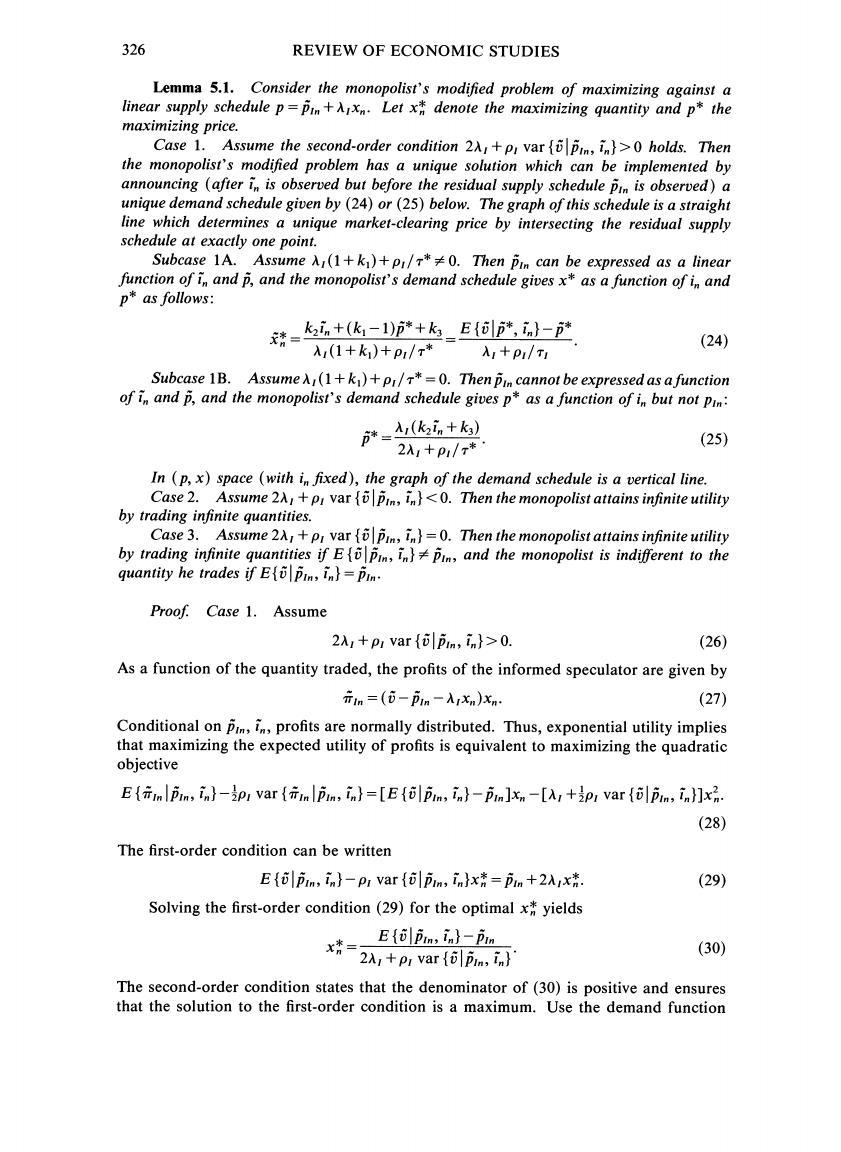
326 REVIEW OF ECONOMIC STUDIES Lemma 5.1.Consider the monopolist's modified problem of maximizing against a linear supply schedule p=pin+x.Let x denote the maximizing quantity and p*the maximizing price. Case 1.Assume the second-order condition 2A1+p var pin,in)>0 holds.Then the monopolist's modified problem has a unique solution which can be implemented by announcing (after i is observed but before the residual supply schedule pin is observed)a unique demand schedule given by(24)or(25)below.The graph of this schedule is a straight line which determines a unique market-clearing price by intersecting the residual supply schedule at exactly one point. Subcase 1A.Assume Ar(1+k)+p/*0.Then pin can be expressed as a linear function of i and p,and the monopolist's demand schedule gives x*as a function of in and p*as follows: 济=。+k,-1)+k_E创方速,- 入(1+k)+P/r* (24) 入,+P1/T1 Subcase 1B.AssumeA(1+k)+p/*=0.Then pin cannot be expressed as afunction of i and p,and the monopolist's demand schedule gives p*as a function of i but not pin: p*=(飞+k) 2入1+P1/x* (25) In (p,x)space (with in fixed),the graph of the demand schedule is a vertical line. Case 2.Assume 2A1+pI var pin,in}<0.Then the monopolist attains infinite utility by trading infinite quantities. Case 3.Assume 2A1+pI var pin,in}=0.Then the monopolist attains infinite utility by trading infinite quantities if Epi,in pin,and the monopolist is indifferent to the quantity he trades if E(pin,in)=pin. Proof.Case 1.Assume 2A1+pi var (o pin,in)>0. (26) As a function of the quantity traded,the profits of the informed speculator are given by 元in=(i-P1nm-入xn)xn (27) Conditional on pim,in,profits are normally distributed.Thus,exponential utility implies that maximizing the expected utility of profits is equivalent to maximizing the quadratic objective E{fm pin,in}-ipI var {fin pin,in}=[E pin,in}-pin]xn-[Ar +ipI var pin,in)]xn. (28) The first-order condition can be written E pin,in}-pi var {o pin,inx=pin +21x (29) Solving the first-order condition(29)for the optimal x yields E pin,in)-pin =2入1+pvar{i, (30) The second-order condition states that the denominator of(30)is positive and ensures that the solution to the first-order condition is a maximum.Use the demand function